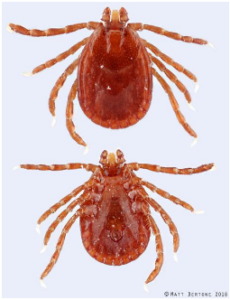Asian Longhorn Ticks: A Growing Menace for Livestock Producers and How to Counter It
go.ncsu.edu/readext?953852
en Español / em Português
El inglés es el idioma de control de esta página. En la medida en que haya algún conflicto entre la traducción al inglés y la traducción, el inglés prevalece.
Al hacer clic en el enlace de traducción se activa un servicio de traducción gratuito para convertir la página al español. Al igual que con cualquier traducción por Internet, la conversión no es sensible al contexto y puede que no traduzca el texto en su significado original. NC State Extension no garantiza la exactitud del texto traducido. Por favor, tenga en cuenta que algunas aplicaciones y/o servicios pueden no funcionar como se espera cuando se traducen.
Português
Inglês é o idioma de controle desta página. Na medida que haja algum conflito entre o texto original em Inglês e a tradução, o Inglês prevalece.
Ao clicar no link de tradução, um serviço gratuito de tradução será ativado para converter a página para o Português. Como em qualquer tradução pela internet, a conversão não é sensivel ao contexto e pode não ocorrer a tradução para o significado orginal. O serviço de Extensão da Carolina do Norte (NC State Extension) não garante a exatidão do texto traduzido. Por favor, observe que algumas funções ou serviços podem não funcionar como esperado após a tradução.
English
English is the controlling language of this page. To the extent there is any conflict between the English text and the translation, English controls.
Clicking on the translation link activates a free translation service to convert the page to Spanish. As with any Internet translation, the conversion is not context-sensitive and may not translate the text to its original meaning. NC State Extension does not guarantee the accuracy of the translated text. Please note that some applications and/or services may not function as expected when translated.
Collapse ▲Some of you may be aware of a tick that is getting noticed a lot more in North Carolina, it is called the Asian Longhorn Tick often abbreviated ALT.
This tick is not necessarily new to this area, in 2010 it reached the United States and started to make its way around the United States. As of May 2022, it has been discovered in 22 different North Carolina counties, including Buncombe, Haywood, Rutherford and other surrounding counties.
The neat thing about this tick is that it can reproduce without a male tick needed. With that being said, the female tick can lay about 900-3,300 eggs at once, and those eggs contain only female ticks. Therefore, the population of these ticks can increase at massive rates.
With these ticks being able to reproduce at such massive rates, this is a concern for livestock producers. That much loss of blood on any livestock can cause poor growth and development, in some cases may cause diseases and in severe instances can result in death.
While all of this is a lot of information, there is still hope for you and your livestock! There are ways to prevent this tick infestation on your livestock. Some ways to prevent it is by treating them with Pyrethroid sprays or pour-on insecticides. As always, if you have any questions, you can reach out to your preferred veterinarian to choose a plan that fits your operation the best. Some other prevention strategies are to check your livestock regularly for ticks, keep the pastures managed so the grass does not get too tall.
For more information, visit NC State’s article, NCDA&CS Asian Longhorn Tick Article, or contact Skyler Murray at (828) 652-8104, or email skyler_murray@ncsu.edu.





